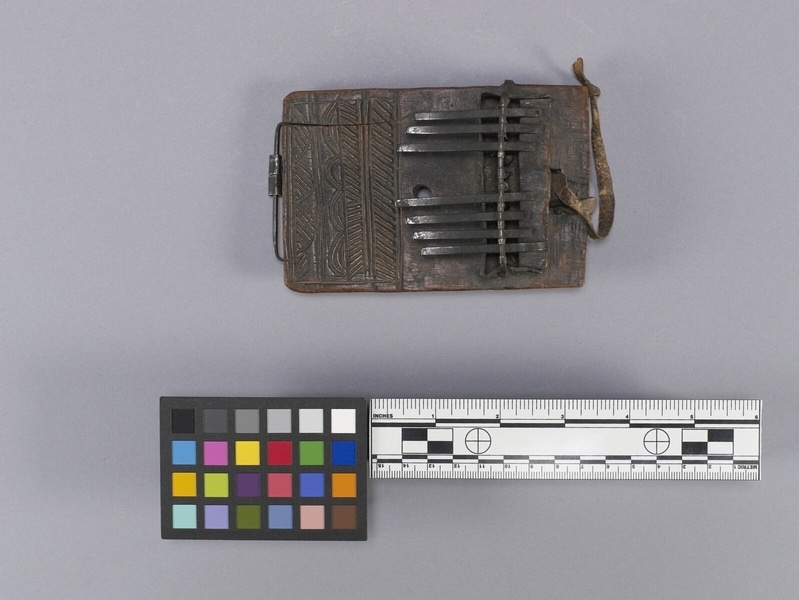Thumb Piano Item Number: Ac253 from the MOA: University of British Columbia



Description
Thin brown smooth-backed wood piece. Narrow rectangular wood platform has on top seven metal tongues (keys), once nine, evenly-spaced in a row, placed lengthwise to the wood piece, and held in place by a lateral bar wrapped in metal strips that are inserted into the wood piece through to the back. Length of knotted hide strung through two holes at same end. Large hole in the middle of the wood piece. Lateral bar inserted in the edge with two loosely-wrapped metal bands. Carved with a main geometric design consisting of four parallel horizontal bands, from top to bottom: diagonal lines, opposing diagonal lines, four double-outlined u-curves, and four upside down u forms with diagonals inside.
History Of Use
The sanza, or mbira (Shona language) is a plucked idiophone (or lamellaphone) that has been in use for thousands of years, and is played widely throughout the African continent. It is known by many different names, e.g., kilembe, likembe, kadono, akogo, timbrh, and thumb piano and has undergone variations, such as the kalimba, but the general style and function remain consistent. The instrument has been played for both secular and ceremonial use, e.g., around the fire during social evenings, or to commicate with the ancestors.
Cultural Context
Musical instrument.
Narrative
The collector, Nellie Taylor, served as a nursing missionary (1900-1920), first with the Ovimbundu at Bihe, then with the Chokwe at luma Kasai. She belonged to a group who sponsored several missions across Central Africa from 1881-1931.
Item History
- Made in Luma Kasai, Angola before 1920
- Collected between 1900 and 1920
- Owned by Nellie Taylor
- Owned by Gladys G. Cameron before January 12, 1979
- Received from Gladys G. Cameron (Donor) on January 12, 1979
What
Who
- Culture
- Chokwe
- Previous Owner
- Nellie Taylor and Gladys G. Cameron
- Received from
- Gladys G. Cameron (Donor)
Where
- Holding Institution
- MOA: University of British Columbia
- Made in
- Luma Kasai, Angola
When
- Creation Date
- before 1920
- Collection Date
- between 1900 and 1920
- Ownership Date
- before January 12, 1979
- Acquisition Date
- on January 12, 1979
Other
- Item Classes
- metalwork
- Condition
- fair
- Accession Number
- 0509/0026